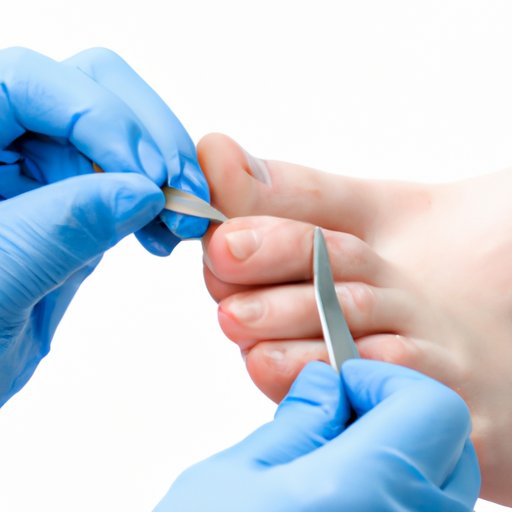
Introduction
Ingrown toenails are painful and potentially dangerous, as they can lead to infection. They occur when the nail grows into the skin instead of over it. This can be caused by improper toenail trimming, tight shoes, or injury. Prevention is key to avoiding ingrown toenails, and this can be done by properly trimming toenails and wearing comfortable, well-fitting shoes.
It is important to properly trim toenails. Nails should be trimmed straight across, rather than curved, and not too short. This can help prevent ingrown toenails from occurring in the first place. If you already have an ingrown toenail, don’t worry. There are ways to get rid of it at home, but if it is severe or infected, it’s best to seek professional medical treatment.
Softening the Skin
Before attempting to remove the ingrown toenail, it’s important to soften the skin around it. There are a number of ways to do this, all of which involve soaking the foot in warm water. Adding Epsom salts or hydrogen peroxide to the water can be helpful as well.
Epsom salts are commonly used to help soften the skin around the toenail. The salts contain magnesium, which can help reduce inflammation and relieve pain. To use Epsom salts, add a half-cup to a basin of warm water and soak your foot for 15-20 minutes at a time, two to three times per day.
Hydrogen peroxide can also be added to the water. This helps to kill bacteria and prevent infection. Add a cup of hydrogen peroxide to the basin of warm water and soak your foot for 15-20 minutes at a time, two to three times per day.
Removing the Ingrown Toenail
Now that the skin is softened, the ingrown toenail can be removed. To begin, gently lift the edge of the toenail out of the skin using a sterile instrument, such as a nail file or tweezers. Be gentle to avoid causing more pain or injuring the nail or skin.
If the toenail is too painful to be lifted out with an instrument, a cotton swab can be used instead. Soak the cotton swab in warm water or hydrogen peroxide and gently lift the nail out of the skin. Be sure to use a fresh cotton swab each time; it is not sterile and can cause infection.
Topical Treatments
After removing the ingrown toenail, it is crucial to use an antibiotic ointment or tea tree oil to prevent infection and promote healing. Antibiotic ointment can be applied directly to the affected area, which should then be covered with a sterile bandage.
Tea tree oil is a natural antiseptic that can be used in place of antibiotic ointment. Additionally, it can help reduce inflammation and relieve pain. To use, mix a drop of tea tree oil with a carrier oil, such as coconut or olive oil, and apply to the affected area. This should also be covered with a sterile bandage.
Professional Medical Treatment
If the ingrown toenail is severe, infected, or has not improved after a few days of at-home treatment, it’s best to seek professional medical treatment. A podiatrist will likely need to remove the portion of the nail that is ingrown. This is done by numbing the toe with a local anesthetic and gently lifting the nail out of the skin. In more severe cases, a portion of the nail may need to be permanently removed.
Myths about Ingrown Toenail Treatment
There are several myths about treating ingrown toenails that need to be debunked. One common myth is that packing the nail with dental floss or cotton will help it grow properly. In fact, packing the nail can cause further damage to the nail and the surrounding skin, leading to infection and more pain. Additionally, attempting to cut or remove the nail yourself can also lead to injury and infection.
Conclusion
Ingrown toenails can be painful and even dangerous if left untreated. Prevention is key, and this can be done by properly trimming toenails and wearing comfortable, well-fitting shoes. If an ingrown toenail does occur, it can usually be treated at home with the softening and removal techniques discussed in this article. Be sure to use topical treatments, like antibiotic ointment or tea tree oil, to prevent infection and promote healing, and seek professional medical treatment if the ingrown toenail is severe or infected. Good foot hygiene is crucial in preventing ingrown toenails from occurring in the future.





